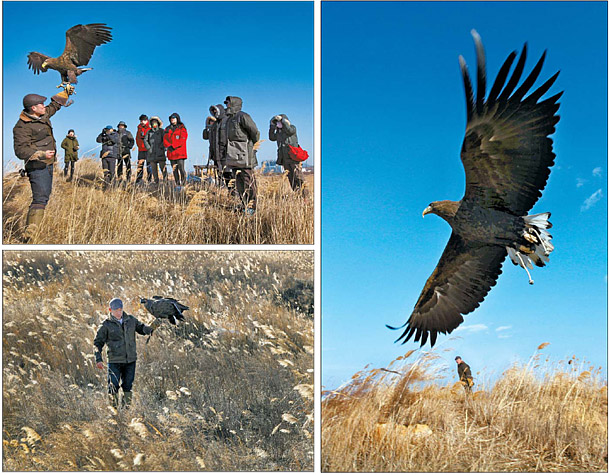[ZOOM KOREA] Helping birds of prey return to the skies

Garam, a white-tailed sea eagle, takes a break with Park Sang-hyun after completing flight training. After Garam completes her hunting training, she will return to her natural habitat around mid-March. [PARK SANG-MOON]
Park Sang-hyun, who was training Garam to fly freely, spoke of the bird brimming with pride near the Anam Pond Cistern in Gimpo, Gyeonggi. Garam is a white-tailed sea eagle, currently in rehabilitation. Garam means river, a name that Park bestowed upon her because the white-tailed sea eagle is a bird that feeds on fish near the waterside.
Garam, with her return to the wild pending, was rescued nearly five years earlier after suffering from a gun wound. She was shot near her rear, but fortunately the bullet missed her organs and spine. As she was caged in a breeding facility for a long time, Garam’s hunting skills and motor reflexes are seriously deteriorated. Garam was handed over to Park Sang-hyun by Jang Hyeon-hye, Gimpo’s branch president of The Korea Association For Bird Protection.
Park is the nation’s only rehabilitation therapist for birds of prey, working with birds such as eagles, owls, kestrels and many more. He is also the Korean representative of the International Association for Falconry & Conservation of Birds of Prey. Birds that are rescued from injuries, drug addiction and exhaustion are returned to their homes after careful nursing and rehabilitation by Park.
Even as a kid, Park was passionate about birds of prey. During weekends and national holidays, he would visit zoos and spend the whole day with birds of prey. One day in 1988, while at the Cheonggye stream in Seoul, where wild animals were often found, he had the opportunity to touch one of the birds with his own hands. At that moment, the young kid made his mind to find a career related to birds of prey.

Top: Visitors to the Anam Pond Cistern in Gimpo, Gyeonggi, look on as the white-tailed sea eagle goes through its rehabilitation training. Bottom: Park Sang-hyun and Garam pass through a field of reeds. Right: Garam showcases her impressive flying skills. [PARK SANG-MOON]
During his high school years, he submitted a request to the school to build a breeding facility for birds of prey and subsequently spent his days breeding the birds. In his university years, he accumulated greater knowledge through participating in activities and projects regarding the reproduction and protection of the birds of prey as well as taking part in rehabilitation projects. After working for various non-governmental organizations, Park decided to come back to Korea to volunteer and help further the knowledge of birds of prey in his home country.
Since coming to Korea, Park has been an active advocate for birds of prey, visiting universities and wildlife rescue centers, giving lectures and writing a manual on the maintenance of birds of prey in the process. In addition to rehabilitation and training, he conducts in-depth research on birds of prey and analyzes the psychology of the birds. Currently, Park is intensively researching artificial reproduction for birds of prey.
The artificial reproduction Park currently conducts concerns permanently disabled birds of prey, allowing them to mate inside a breeding facility. Offspring from the disabled birds cannot develop properly due to the defects of the parents. The parents can only take care of their offspring to a certain extent, and after that period, the young must learn to survive on its own and return to the wild.
There are countless birds of prey that have returned to their homes because of Park’s contributions. Park says the most touching moments are when birds of prey with serious injuries return to the wild after being fully cured through his rehabilitation program. Park, who has had an affinity towards birds of prey since he was young, said he was thankful to be able to work for the birds.
Park reiterates that nature and wildlife are not too distant from humans. Humans are a part of nature, and wildlife is also a part of what makes up Earth. However, the greed of humans is destroying nature and ecosystems and is increasingly putting the lives of birds of prey in danger. Park is working to find and protect the birds’ habitat, cultivate the forest and create a base of survival for these birds of prey.
BY PARK SANG-MOON [moonpark@joongang.co.kr]










with the Korea JoongAng Daily
To write comments, please log in to one of the accounts.
Standards Board Policy (0/250자)